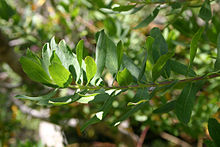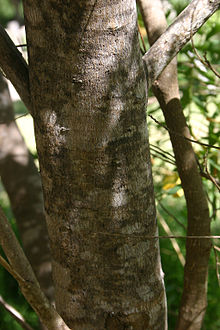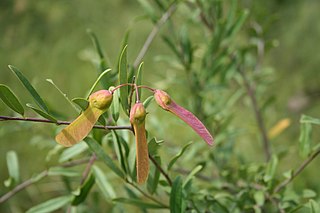
The Polygalaceae or the milkwort family are made up of flowering plants in the order Fabales. They have a near-cosmopolitan range, with about 27 genera and ca. 900 known species of herbs, shrubs and trees. Over half of the species are in one genus, Polygala, the milkworts.
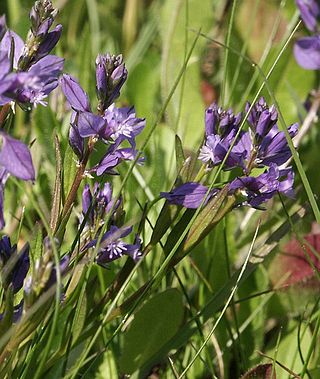
Polygala is a large genus of flowering plants belonging to the family Polygalaceae. They are commonly known as milkworts or snakeroots. The genus is distributed widely throughout much of the world in temperate zones and the tropics. The genus name Polygala comes from the ancient Greek "much milk", as the plant was thought to increase milk yields in cattle.

Polygala vulgaris, known as the common milkwort, is a herbaceous perennial plant of the genus Polygala in the family Polygalaceae.

Arctotheca calendula is a plant in the sunflower family commonly known as capeweed, plain treasureflower, cape dandelion, or cape marigold because it originates from the Cape Province in South Africa. It is also found in neighboring KwaZulu-Natal.

Plectranthus verticillatus, Swedish ivy, Swedish begonia or whorled plectranthus is a plant in the family Lamiaceae (Labiatae), genus Plectranthus. Despite its common name, it is not close to the ivy family of the genus Hedera.
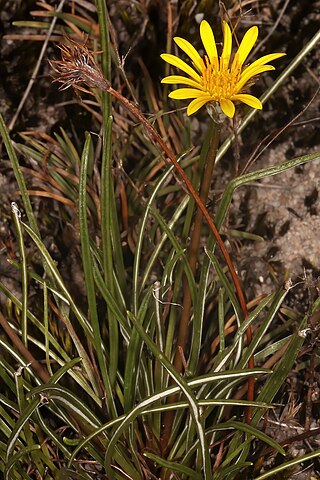
Gazania linearis is a species of flowering plant in the family Asteraceae, with thin linear leaves, native to South Africa.

Acacia myrtifolia, known colloquially as myrtle wattle, red stem wattle or red-stemmed wattle, is a species of Acacia native to coastal areas of southern and eastern Australia.

Ehrharta calycina is a species of grass known by the common names perennial veldtgrass and purple veldtgrass.

Areas of forest which grow in KwaZulu-Natal, South Africa mostly on south facing slopes in higher rainfall areas, and along the humid coastal areas. Different types of forest can be identified by their species composition which depends mostly on the altitude, latitude and substrate in which they grow. South facing slopes are favourable for the development of forest as they are more shaded, and therefore cooler and retain more moisture than the northern slopes. The extra moisture on the south slopes is not only favoured by forest trees, but also helps to prevent or subdue wildfires. Fires can also be blocked by cliff faces and rocks or boulders on these slopes, and by streams or rivers at the base of the slopes. The coastal regions are conducive to forest formation, because of high rainfall and humidity which are favoured by forest trees and also help to prevent or subdue fires. The rivers of the coastal areas are also broader than further inland, which may often prevent fires from spreading long distances, and fires generally burn uphill and therefore more often away from areas at low altitude.

Rhinotropis californica, synonym Polygala californica, is a species of flowering plant in the milkwort family known by the common name California milkwort. It is native to southwestern Oregon and northern and central California, where it grows in the coastal mountain ranges in local habitat types such as chaparral and forest. It is a perennial herb producing spreading stems, generally decumbent in form, up to about 35 centimeters in maximum length, lined with narrow oval leaves each a few centimeter long. The upper inflorescences produce several open flowers, and there may be some closed, cleistogamous flowers lower on the plant. The open flowers have pink or white winglike lateral sepals with hairy edges. The petals are similar in color, the central one tipped with a white or yellow beak. The fruit is a flattened green capsule up to a centimeter long containing hairy seeds.
Rhinotropis heterorhyncha, synonym Polygala heterorhyncha, is a species of flowering plant in the milkwort family known by the common names beaked spiny polygala and notch-beaked milkwort. It is native to southern Nevada and it is known from a few occurrences just over the border in the Funeral Mountains of California above Death Valley. It is a resident of desert scrub habitat. This desert plant is a perennial herb or small shrub growing in small clumpy mats. The thin, branching, thorny-tipped stems are somewhat waxy in texture and sometimes slightly hairy. They are lined sparsely with small oval, dull-pointed leaves. The inflorescence bears a few flowers, each with a winglike pair of bright pink sepals and a yellow-tipped central petal. The fruit is a vein-streaked capsule.

Millettia grandis is a species of plant in the family Fabaceae from South Africa. It is commonly called umzimbeet which is a name derived from the isiZulu name umSimbithwa.

Mimusops caffra is a species of tree in family Sapotaceae. This tree is found in coastal dune vegetation in Southern Africa from the Eastern Cape, through KwaZulu-Natal to southern Mozambique.
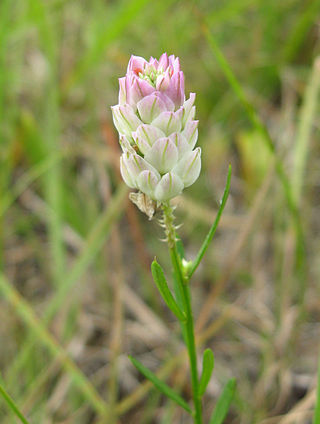
Polygala sanguinea, known as purple milkwort, field milkwort, or blood milkwort is an annual plant in the Polygalaceae (milkwort) family. It is native to central and eastern North America.

Polygala lutea, commonly known as orange- or yellow milkwort, is a plant in the milkwort family (Polygalaceae) native to pine-barren depressions and swamps in coastal areas of the southern and eastern the United States. It was first described in 1753 by Carl Linnaeus.

Gasteria croucheri is a succulent plant, native to KwaZulu-Natal Province, South Africa.
Polygala bifoliata is a species of flowering plant in the milkwort family (Polygalaceae), which was first described in 2012 by Raelee Kerrigan. It is endemic to the Northern Territory and Western Australia.

Polygala linariifolia is a species of flowering plant in the milkwort family (Polygalaceae). It extends worldwide, including in the Australian states of New South Wales, Queensland, Northern Territory and Western Australia, however due to obscure taxonomic classifications and similarities and cross-overs between other Polygala species, it is difficult to confirm the exact identity of P. linariifolia and its distribution across the world including Australia.

Polygala ramosa is a species of flowering plant in the milkwort family (Polygalaceae). It is endemic to the coastal areas of the Southern and Eastern United States. It is an annual herb with a height of 10 to 40 centimetres that produces yellow flowers between the months of May and September.

Polygala rehmannii is a species of flowering plant in the milkwort family (Polygalaceae). It is endemic to areas with an altitude below 1,160 metres (3,810 ft) in Southern Africa. It was first described by Robert Chodat in 1893.

